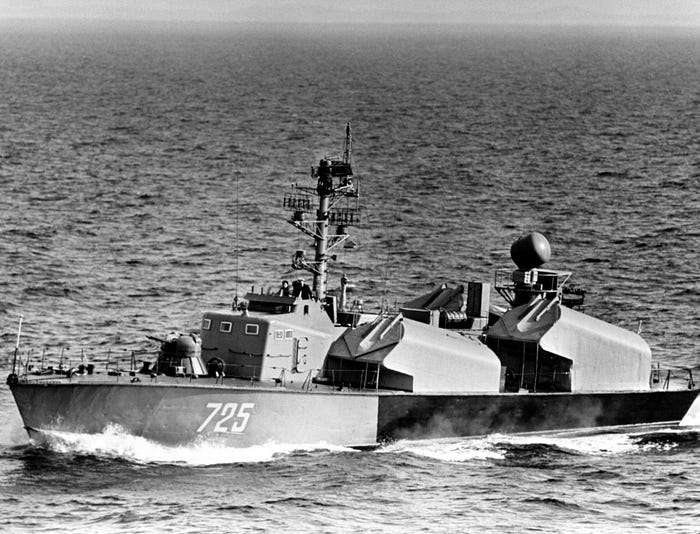Vidyut Class Missile Boats: All You Need To Know

On December 4, 1971, the Pakistani Navy received a rude awakening in the form of six anti-ship cruise missiles fired from Indian Navy’s Vidyut-class missile boats. In 90 minutes, the tiny (compared to the targets they downed) boats sank three PNS vessels and destroyed the oil storage facilities at Karachi harbor.

This proud day is now celebrated as ‘Navy Day’ by the Indian defense forces. While a lot of the credit rests on the steely seamanship of the sailors operating the vessels, not much is known about the ships themselves. The Vidyut-class missile boats were a Soviet experiment in developing light, fast attack craft for coastal defense. That they proved fierce warriors in Operation Trident was a surprise for everyone, especially the aggressors, the Pakistani Navy.
Here’s all you need to know about the fiercest boats in the Indian navy.
- They were originally designated as the Osa-1 by the Soviets and were never intended to fight in the high seas.

2. The Osa-1 weighed up to 209 tons when fully loaded.

3. The Osa-1 aka Vidyut-class had a maximum range of 1,800 nautical miles (3,300 km) in max endurance mode ( a speed of 14 knots)

4. Osa-class/Vidyut-class boats could survive for up to five days at sea, with a complement of 28, which included four officers.
5. The hull was made of steel, compared to the wooden one used in its predecessor, the Komar-class missile boat.
6. The missile boats were powered by 3 diesel engines with up to 5000 hp each, depending on the configuration, bringing the total actual power output to between 12,000 to 15,000 hp.
7. Powered by the M-503G series engines, they had a maximum speed of 38.5 knots, which rose to 42 with the M-504B series diesel power units.
8. The engines were placed in two separate engine rooms, with two in the forward position, and the third in the aft section.

9. There were a total of three independent electrical power generators onboard.
10. Two AK-230 anti-aircraft guns were placed on the forward and aft deck, each linked to an MR-104 Rys (NATO — Drum Tilt) fire control radar.
11. The AK-230 guns were unmanned, had a 30-mm barrel, and could fire up to 2,000 rounds per minute to a maximum range of 2,500 meters. (This was the first close-in weapon system ever deployed onboard a Soviet attack craft).
12. Unlike the Komar class, which had unprotected missile magazines, the Osa-series of boats had sturdy, well-armored missile boxes that could take a lot of punishment from the sea.
13. The primary armament was the P-15 Termit (Termite in English) missile developed by the USSR.

14. The missile was also called the Styx or the SS-N-2 and is considered one of the most effective anti-ship missiles to ever emerge from Soviet Russia.
15. The Styx missile weighed 2,580 kg, was 5.8 meters long, and 76 cm wide.
16. The Osa-1’s primary armament, the Styx missile, carried a 454 kg high-explosive warhead that could punch holes through the biggest ships.
17. Though the 40-km range might seem implausible today (the Brahmos can do up to 300km), it cruised at 0.95 times the speed of sound.

18. The Soviets could have used a turbojet, but an acid-fueled rocket-engine proved more reliable and cheaper.
19. Additionally, the warhead was placed in front of the fuel tank, which added to the explosive energy released upon detonation.
20. The missile was quite fuel-efficient, since, even at maximum range, it used a little over half the onboard fuel.

21. In the War of Attrition, after the Yom Kippur War in 1967, the Styx missiles were used to sink a destroyer, albeit on board the older Komar-class vessels used by the Egyptian Navy.
22. An Iranian fast-attack craft was sunk by Iraq using Styx missiles during the Iran-Iraq War.
23. The Styx missiles were like AK-47s — cheap, heavy, reliable and produced by the thousands.
24. Current operators include India, China, Iran, Russia, Syria, Sri Lanka, and Vietnam, although some countries made modifications to the basic design.
25. The United States acquired a 200-missile package from Germany in 1991, which it used to test and develop its anti-ship missiles.

26. To prepare for Operation Trident, top Indian naval staff were sent to the USSR.
27. There, they were trained in Russian, which proved very useful because though the Pakistani Navy could intercept radio communications, it was in Russian so they could not understand anything.
28. The biggest target sunk by a Vidyut-class boat (INS Nirghat) was the PNS Khaiber, a Battle-class destroyer.

29. The INS Nipat, the second missile boat in the attack fleet fired missiles that destroyed the merchant ship MV Venus Challenger, which was carrying fuel and ammunition for the Pakistan army and air force. She also damaged the PNS Shah Jahan, a destroyer.

30. The third missile boat, the INS Veer, sank the PNS Muhafiz, a minesweeper.

31. The Pakistanis thought it was an air attack, and in the confusion, sank one of their own ships, the PNS Zulfiqar.

32. The three missile boat commanders, Lt. Cdrs. BN Kavina, IJ Sharma and OP Mehta were awarded the Veer Chakra.
33. Commander B.B.Yadav, their squadron commander also received the Mahavir Chakra.
Yes, the boats had a shorter range compared to the more powerful destroyers and corvettes they had to face. But, did you know that they were towed from Mumbai to Karachi? Yes. The Indian Navy hit upon this idea while transporting the Vidyut-class boats from Kolkata to Mumbai, their base of operations.

The Indian Navy struck such a powerful blow that news of the attack was the first item on the-then President Nixon’s daily briefing with the CIA. In a subsequent attack, Operation Python, the Indian Navy destroyed three tankers and additional fuel and ammo storage dumps. The Indian Navy caused up to $3 billion in damages. More important, however, was that by neutralizing the fuel storage facilities at Karachi, the Pakistani Navy and Air Force had to contend with severe fuel shortages. Then, to rub salt into the wound, neutral vessels deemed the trip to Pakistan too dangerous and ceased all shipping, effectively sealing the Indian Navy’s blockade of Karachi.
On the way home, a sailor climbed up the missile hangar of the INS Nipat and painted the words “The Killers”, and thus the “Killer Squadron” was born.
The Indian Navy commemorates this immense win by celebrating December 4 as ‘Navy Day’.
Jai Hind
